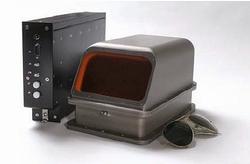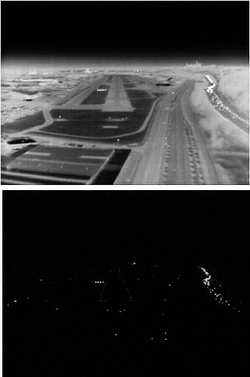Sun, Mar 02, 2003
 Max-Viz Inc. has been selected by a Boeing B767
operator to supply the EVS-2500 Enhanced Vision System for this
customer’s new aircraft. Max-Viz is developing a
radome-mounted installation of its EVS that will suit this aircraft
type with partners Nordam of Ft. Worth, TX and Associated Air
Center of Dallas, TX. The company anticipates system installation
in late 2003 with FAA certification in 2Q04.
Max-Viz Inc. has been selected by a Boeing B767
operator to supply the EVS-2500 Enhanced Vision System for this
customer’s new aircraft. Max-Viz is developing a
radome-mounted installation of its EVS that will suit this aircraft
type with partners Nordam of Ft. Worth, TX and Associated Air
Center of Dallas, TX. The company anticipates system installation
in late 2003 with FAA certification in 2Q04.
 The operator chose the Max-Viz system over
competing products due to its superior performance, much higher
reliability and smaller size. Another factor in their decision is
the belief that EVS will offer a significant safety advantage for
their international operations. This is the first application of
EVS on a commercial air transport category aircraft.
The operator chose the Max-Viz system over
competing products due to its superior performance, much higher
reliability and smaller size. Another factor in their decision is
the belief that EVS will offer a significant safety advantage for
their international operations. This is the first application of
EVS on a commercial air transport category aircraft.
The EVS systems developed by Max-Viz employ uncooled infrared
(IR) sensors to generate video-like images of the area in front of
an aircraft in flight and on the ground which can then be displayed
on any video-capable display in the cockpit or cabin. The systems
allow the pilot to autonomously ensure the safety of aircraft
operations during taxi, takeoff, approach and landing. IR images
can augment the normal visual scan when outside viewing is degraded
and is particularly effective at night, in smoke, haze and
smog.
 The EVS-2000 family of products is dual sensor
systems using a long-wave IR sensor (best for “seeing”
scene details) and a short-wave IR sensor (best for airport and
runway lights). The two sensor outputs are combined using a
patented process into a single image by a separate fusion
processor. The image on the B767 will be displayed on a cockpit MFD
that is video-capable.
The EVS-2000 family of products is dual sensor
systems using a long-wave IR sensor (best for “seeing”
scene details) and a short-wave IR sensor (best for airport and
runway lights). The two sensor outputs are combined using a
patented process into a single image by a separate fusion
processor. The image on the B767 will be displayed on a cockpit MFD
that is video-capable.
EVS technology is rapidly gaining recognition in the industry as
a key element in the prevention of CFIT and the early detection of
runway incursions. “We are very pleased to have been selected
by a sophisticated operator who recognizes the value of EVS and is
willing to take a leadership position in implementing it,”
commented Max-Viz President Gregg Fawkes. “This effort will
pave the way for EVS entry into the commercial air transport
marketplace.”
More News
Aero Linx: Aviators Code Initiative (ACI) Innovative tools advancing aviation safety and offering a vision of excellence for aviators. The ACI materials are for use by aviation pra>[...]
Make Sure You NEVER Miss A New Story From Aero-News Network Do you ever feel like you never see posts from a certain person or page on Facebook or Instagram? Here’s how you c>[...]
From 2016 (YouTube Edition): Who You Gonna Call When You Have a Rocket Engine that Needs a Spacecraft? While at EAA AirVenture 2016, ANN CEO and Editor-In-Chief, Jim Campbell, sat >[...]
"In my opinion, if this isn't an excessive fine, I don't know what is... The odds are good that we're gonna be seeking review in the United States Supreme Court. So we gotta muster>[...]
Expedite Used by ATC when prompt compliance is required to avoid the development of an imminent situation. Expedite climb/descent normally indicates to a pilot that the approximate>[...]
 ANN's Daily Aero-Linx (04.30.25)
ANN's Daily Aero-Linx (04.30.25) ANN FAQ: Turn On Post Notifications
ANN FAQ: Turn On Post Notifications Classic Aero-TV: Agile Aeros Jeff Greason--Disruptive Aerospace Innovations
Classic Aero-TV: Agile Aeros Jeff Greason--Disruptive Aerospace Innovations Aero-News: Quote of the Day (04.30.25)
Aero-News: Quote of the Day (04.30.25) ANN's Daily Aero-Term (04.30.25): Expedite
ANN's Daily Aero-Term (04.30.25): Expedite





